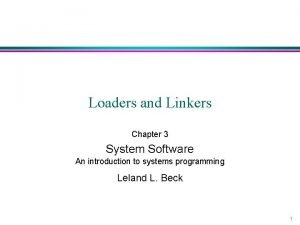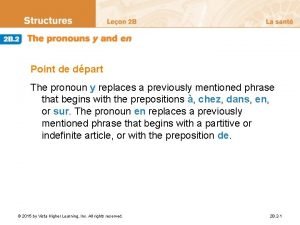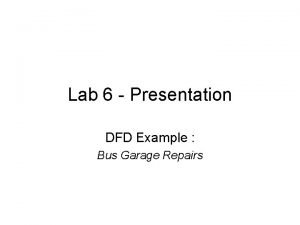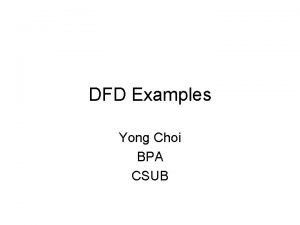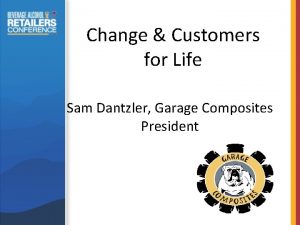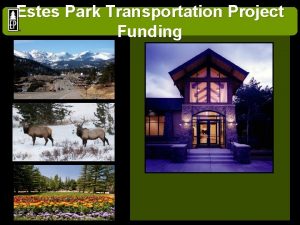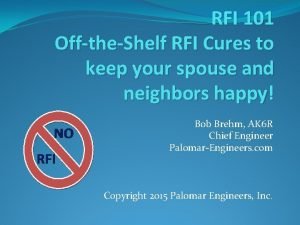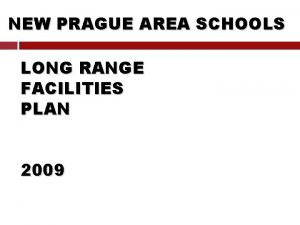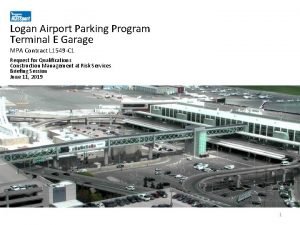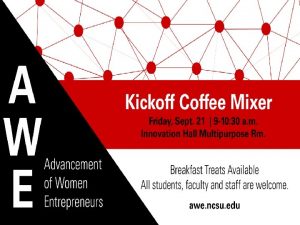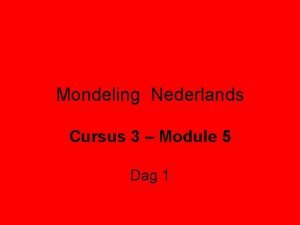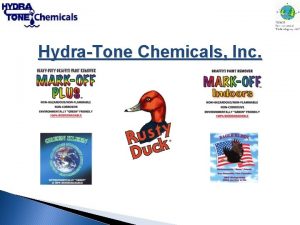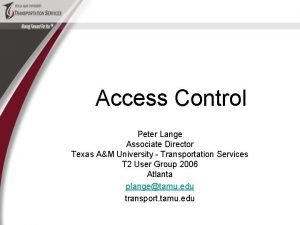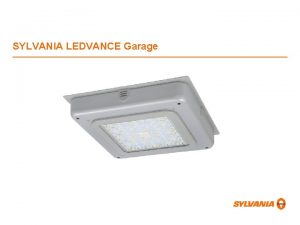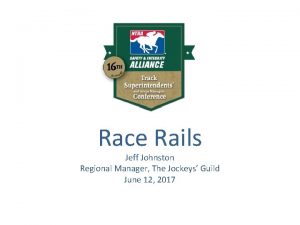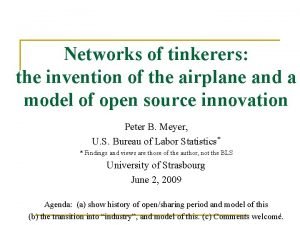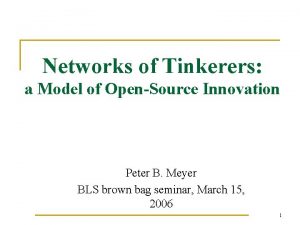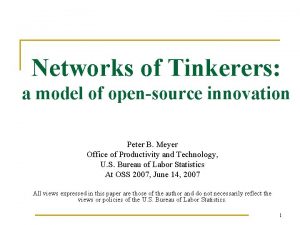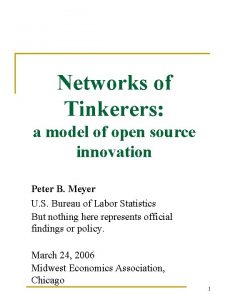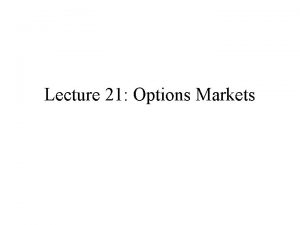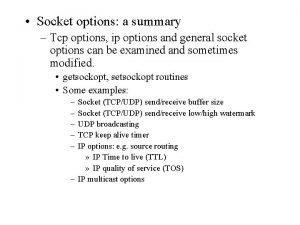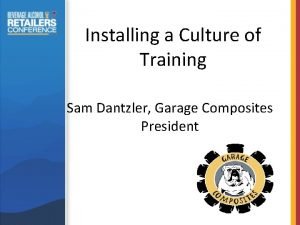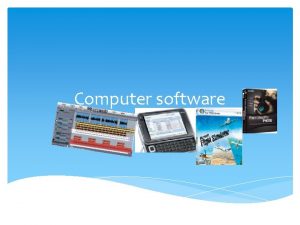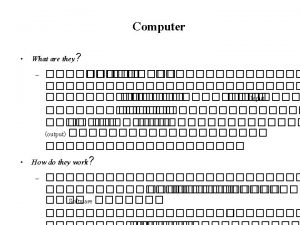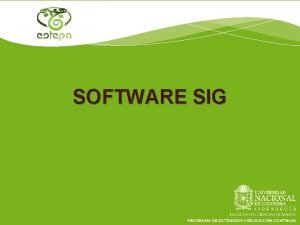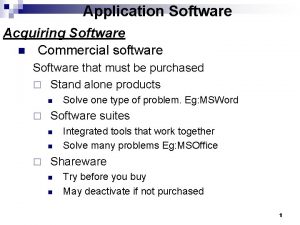Software Jockeys or Garage Tinkerers Training Options for




































- Slides: 36

Software Jockeys or Garage Tinkerers Training Options for Next-Generation Geomechanicists Institute of Petroleum Engineering School of Energy, Geoscience, Infrastructure and Society Heriot-Watt University Prof Gary Couples SPE London Section – 27 Oct 2015

Prof Gary D Couples B. S. – Texas A&M (Geology) 1974 M. A. – Rice Univ (Geology) 1977 Ph. D. – Texas A&M (Tectonophysics) 1986 Cities Service (Tulsa, 1980), Amoco (Denver, 1980 -88) • Univ of Glasgow (1989 – 1998) • Heriot-Watt Univ (1998 – at least today! ) • Engineer/Geologist • •

Preview • In this talk, I wish to challenge our collective comfort concerning our level of skills and our understanding of geomechanical principles – and thus what we can actually deliver to users • I suggest that we need to develop and support focused training (at MSc level) that will deliver a next-generation of specialists who can ensure that geomechanics becomes an essential element of successful resource exploitation

The Basics “Strain” is a surname that is not all that rare in Scotland! (several hundred entries on telephone directory search) This is a shoe store in Oslo. I have seen stress-relieving shoes on sale before, but shoes “for” stress? … ? What is the relationship between stress and strain?

A “Feel” for Geo. Materials • Some people have very good intuition about material behaviour (their brain computes material responses) • They can predict outcomes very well • When observing deformation results, they quickly see the important features and do not get lost in the background detail • This skill can be enhanced by training, but I do not know if it can be created in everyone My training agenda is based on the potential to improve these skills

Outline • Few words on constitutive relationships (the underpinning concept of geomechanics), and the relevance of deep understanding of stress and strain • Three examples • Next-generation skills – and how to develop them www. jamescomans. com

stress = f (strain, x, x, x) STRESS • Called a constitutive relationship • Based on continuum concepts (but we choose to use this in porous geomaterials) • Stress is the dependent variable (intensive) • Wide variety invented to suit many purposes • Range from “simple” (i. e. linear elasticity) to considerably more complex (e. g. elasto-hypovisco-poro-plasticity) • Beyond linear versions, the equations can look pretty scary…

Ubiquitous • EVERY geomechanical analysis involves choices about constitutive laws (perhaps largely un-recognised) • : this is where things go wrong… • If someone actively avoids making the choice, they tacitly accept rules and workflows that may be completely inappropriate to the task

A Simple Law • Linear elasticity: – Linear relationship between stress and strain – Reversible, recoverable – No time dependency s e Because of the linearity, we can exchange the dependent and independent variables…

Is Elasticity a Good Model? A lab test on a rock Radial confinement, loaded to “failure” Ds e Is elasticity an appropriate description of the pre-failure response? Well…. that depends. If we want to identify a limit to the set of “non-failure” states, then we might be OK with that choice. If we wish to understand pre-cursors to failure, then probably not. And, if we wish to take this result to Nature, we may be in trouble: fluid-activated creep at pre-failure loads, thermally-enhanced creep, differential cementation and dissolution associated with load-chains, untested conditions, poro-elasticity, …

Elastic-Perfectly Plastic Law This law can be selected in many software packages, and it needs few parameters. So, it is a simple one, and – it is made available by the vendor, so it must be OK, isn’t it? ? Ds The Q: Does it capture key behaviours? e The post-yield part of this constitutive law is normally implemented with the assumption of no volumetric strain. And the material neither “hardens” nor “softens” as it continues to strain. Thus, the chosen constitutive law says that the material enters the critical state at yield, regardless of mean stress. These characteristics are NOT what we see in lab experiments.

Poro-Materials • Mean-stress dependence • Dilation/compaction • Hardening/softening • Localisation • Critical state

Stress and Strain • They are not just numbers. Stress tells us about the (local) state of elastic energy; strain tells us about the local displacement gradient • If we plug s-e numbers into formulae, without due consideration of how those numbers came to exist, or what we are doing with them, or what we imply, we are guilty of (insert one or more of the following: innocence, ignorance, laziness, deception, malpractice, xxx, …)

Also: Skill of Operator • Constitutive laws have limited use unless they are used in simulation • Operating simulation software requires a HIGH level of skill, an understanding of constitutive laws, knowledge of the many simulation pitfalls, and ability to perform “reality checks” Concerns over “workflow” Run geomechanics buttons that replace the rational operator Simulations by Helen Lewis

(some) Application Topics • • • Site geotechnics Drillbit/rock interactions Well stability Perforating Stimulation Reservoir performance and management – – – Pre-existing state of rocks (shape, properties) Fractured reservoirs Overburden Fault barriers Topseal Courtesy Baker-Hughes • Tectonic and basin processes (geological history, overpressure, fluids and heat, …) Source of knowledge

Wellbore Stress State Saleh (1985) modification of Kirsch (1898) analytical solution vs elastic numerical solution The difference is due to the fact that the analytical solution is for a situation that does not exist: sr ≡ 0 at r = constant Ph. D study by Khalid Al. Ruwaili Differences are even larger if we simulate drilling (excavation) Analytical solution for wellbore stress state provides poor estimate near wellbore walls Fractures (mostly shears!) induced by wellbore pressurisation

Hydraulic Fracturing Q: Where does the “lost” injection water go? Injected fluid does not enter the matrix pore space, so has NO impact on effective stress. Hydraulic fluid only carries load to the fracture faces (Pfrac > Ppore) – but Ppore ↑ w/ stress due to poro-elastic response associated with elastic strain in inter-frac regions. The lost water must reside in cracks/fractures. If these were “open” before the stimulation, then similar arguments would apply – namely that the fluid pressure would quickly become too high to continue injection. Therefore, the stimulation process must cause a major dilation via creating/opening cracks in the rock mass. These may not get any proppant… but may experience shear and thus possess residual apertures.

Insights, not Technology • The preceding two examples are not based on any fancy technology. They illustrate the point that joined-up thinking about materials and behaviours can lead to insights, and answers. • Most importantly, these two examples highlight the need to examine whether familiar equations, and the numbers plugged into them, are suited to the real task

Fractured Reservoirs This example DOES require technology – but nothing really unusual. The numerical simulation tool provides poro-material laws, and laws for pre-defined cohesive/frictional discontinuities. These two simulations illustrate the role of frictional rock-layer interfaces in terms of their role in a flexural slip process. The calculated permanent strains (bright colours) are very different depending on whether slip is not possible (upper part of left model), versus where it is (right model). The resulting strains can be transformed to flow or acoustic properties, directly (using some equation), or by down-scaling to an equivalent array of deformation features, such as fractures, and upscaling their effects in an explicit way. If we CHOOSE to simulate the deformation using a tool that does not have the capability of frictional interfaces, we will calculate very large strains, and the strain patterns will be very different, compared to the case with discontinuities. Selecting methods, and building/running models, is a specialist skill that is developed by means of integrated training.

Quo Vadis? • Glen’s survey identifies challenges for us: – Time/cost of doing geomechanics If we agree that there is a need to upgrade – It is disruptive training INSIDE the geomechanics – No one understands it community, it is not a surprise that nonspecialists think we have arrived from Mars… – “No confidence” – Companies do it to prove “due diligence” and for reasons of “loss avoidance”, but not seen as a means for advantage – Lack of much evidence that it impacts business • What to do? ? ?

Herding cats is not easy An Opinion (Risky!) • Much of what I see being done today is the calculation of some numbers that are based on simple models (or just the accepted equation) and easy (proxy? ) parameters • I see little questioning, or integration with other disciplines, or extended “value” interpretations (but perhaps the door is barred to us? ) • We need to boost our credibility – big time!

How? Ideas for getting this message out? • Develop an attitude that geomechanics has the same relevance as depositional models etc, in terms of explaining properties and predicting operational consequences • This needs more intensive (re)training See later • It probably needs some benchmark demonstrations – NOT of software, but of derived value Not addressed in this talk

Desired Learning Outcomes • Educational best-practice says that curriculum design starts with the outcomes – what graduates (practitioners) are expected to be able to DO • Next slide lists the skills required to accomplish a generic task of the sort that could be expected for a next-generation geomechanicist

Next-Generation Skills • Ability to translate a real-world issue into a problem statement, and solve the problem to a reasonable point – – – Understand the language and mind-set of the people who have the issue Obtain info, data, ideas from those people, and others Decompose the tangled problem into logical cause/effect strings Ability to select appropriate material laws Conduct geomechanical analysis (simulation/reasoning) Assess plausibility of calculated results Translate continuum/upscaled strains into geological features Convert outcomes to useful parameters (effective perms, etc) Communicate to recipients, and the management Consider what is needed to improve the analysis for “next time” Undertake upgrades of workflow …

Importance of Soft Skills • Many skills on this list involve communication and team interactions • Even the most-technical skills require interfacing with other humans… • …and contextual nouse • So, team projects! On-the-job learning is great, but should be appropriately structured and supported

Training • Comments here focus on MSc level • They relate to a vision to create nextgeneration subject leaders, and not service operatives • This vision requires that graduates know BOTH petroleum engineering and geomechanics… • …and how to connect these disciplines

A Precedent • In 1975, as the North Sea began its primetime, the UK-based Industry asked academics in the UK to establish a training programme to create the staff needed • IPE was created then, and is celebrating 40 years… THIS WEEK! • Others followed • Why not do that again?

A Design for Master Qualification • Next slides illustrate the curriculum that could achieve this training • They summarise two existing Master-level programmes – which are located in different places (HWU and Grenoble) • What incentives would entice someone to go through the combination over two years? There agreements in place, and official approvals, for operating this combined programme

Petroleum Understanding • • • • Sedimentology Wireline Theory and Practice Drilling Operations Petrophysics/Rock Physics Completions and Stimulation Well Testing Structural Geology Reservoir Geophysics Geomodelling Reservoir Engineering Reservoir Simulation Economics/Business Team/Individual Projects This is a full MSc programme (interface of geology and reservoir engineering) that is taught in 11. 95 (hard) months. Graduates are sought-after as new-hires, and they are viewed as “job ready”. Some continue to Ph. D. However, the Companies that hire them know that there is still a need for gaining experience and deepening of knowledge. Impossible to squeeze this into a few days of lectures! http: //www. postgraduate. hw. ac. uk/prog/msc-reservoirevaluation-and-management/

Geomechanics Understanding • • • Basic Geomechanics Topics in Continuum Mechanics Rock Mechanics Numerical Methods in Non-Linear Mechanics Strain Localisation in Geomaterials Experimental Geomechanics Granular Geomechanics Reservoir Geomechanics Wellbore Geomechanics Basin Geomechanics Individual Project This is the second year of a 2 -yr Master programme involving 1 st year training in one of ~20 European HEIs); it is taught in 10 (hard) months, in English. Graduates obtain jobs in geotechnics, petroleum, or continue to Ph. D Impossible to squeeze this into a few days of lectures! http: //www. grenoble-inp. fr/masters-/master-geomechanics-civil-engineeringand-risks-482560. kjsp#page-presentation

Could We? • Incentive: working with SPE (or others? ), could we establish a suitable award/qualification for this extended MSc-level training? To meet the goals, it needs careful vetting of graduates. • It could be possible/desirable to enable multiple Res. Eng MSc programmes to provide the foundation year • Currently, do not see duplicating the Grenoble success elsewhere… but open to the possibility

An options-appraisal needs to include ALL of the possible paths A Pipe Dream • “We” can raise the bar – and insist that robust approaches to geomechanics be adopted, or else we embarrass operators for simply doing lip-service (vigilante time!) • This might not be very comfortable for those amongst us who earn a living by providing those services… • We need to demonstrate commercial impact • In any case, we need a next-generation

Software Jockey Sir: The computer says that this failure is caused by an incorrect colour for your vehicle. I guess we can schedule you in for a paint-job next week? Hmmm, it does not recommend a safe colour… Do you know anyone with a car that still runs? What colour is it? Not sure if we have any of the right paint… Were you the one who chose this colour originally? I’m sure this is not OUR fault…. It is “easy” to train someone to run a callcentre desk, but perhaps a bit more difficult to train them to solve problems

Garage Tinkerer (ignoring HSE concerns!) This person has my vote of confidence in terms of being able to apply skills and tools to the solution of a problem which may not fit into the “normal” category Practitioners of this type want to know how EVERYTHING works, and then they try to make it better. Sometimes they have opportunities to learn a lesson…

Conclusion • I am not “against” the acquisition of software skills – far from it! But I want those skills to exist in people who understand the design choices of the software’s algorithms, and maybe some ability to makes changes. . . I also want those people to be able to translate the software’s outputs into meaningful forms.

The End • I hope I have made it clear that I am not seeking to ruin anyone’s livelihood • In order to win, we should accept that we can benefit by aiming higher, and maintain that approach long enough to gain (back? ) the industry-wide confidence that is missing today Now, I will try to be brave and take your questions
 Static vs dynamic linking in os
Static vs dynamic linking in os Loaders in system software
Loaders in system software Dts 12r manual
Dts 12r manual Great gatsby locations map
Great gatsby locations map I found him in the garage on a sunday afternoon
I found him in the garage on a sunday afternoon Papa est au garage? oui, il
Papa est au garage? oui, il Bus garage repair dfd
Bus garage repair dfd Zero level dfd
Zero level dfd Data flow diagram level 1 2 3
Data flow diagram level 1 2 3 Garage composites
Garage composites Doppelparker sanierung kosten
Doppelparker sanierung kosten Edmonton garage door installation
Edmonton garage door installation Freehold garages for sale near me
Freehold garages for sale near me Estes park parking garage
Estes park parking garage Dts gsm module
Dts gsm module Bust a knuckle
Bust a knuckle Garage band
Garage band Pickens school bus office
Pickens school bus office Rfi filter for garage door opener
Rfi filter for garage door opener New prague bus garage
New prague bus garage Garage mpa
Garage mpa Ncsu entrepreneurship garage
Ncsu entrepreneurship garage Elmira city school district bus garage
Elmira city school district bus garage The dragon in my garage
The dragon in my garage Garage meervoud
Garage meervoud Rusty duck black powder solvent
Rusty duck black powder solvent Cira south garage
Cira south garage Southside garage tamu
Southside garage tamu Kontinuitetshantering
Kontinuitetshantering Novell typiska drag
Novell typiska drag Tack för att ni lyssnade bild
Tack för att ni lyssnade bild Ekologiskt fotavtryck
Ekologiskt fotavtryck Varför kallas perioden 1918-1939 för mellankrigstiden
Varför kallas perioden 1918-1939 för mellankrigstiden En lathund för arbete med kontinuitetshantering
En lathund för arbete med kontinuitetshantering Särskild löneskatt för pensionskostnader
Särskild löneskatt för pensionskostnader Personlig tidbok
Personlig tidbok Sura för anatom
Sura för anatom

